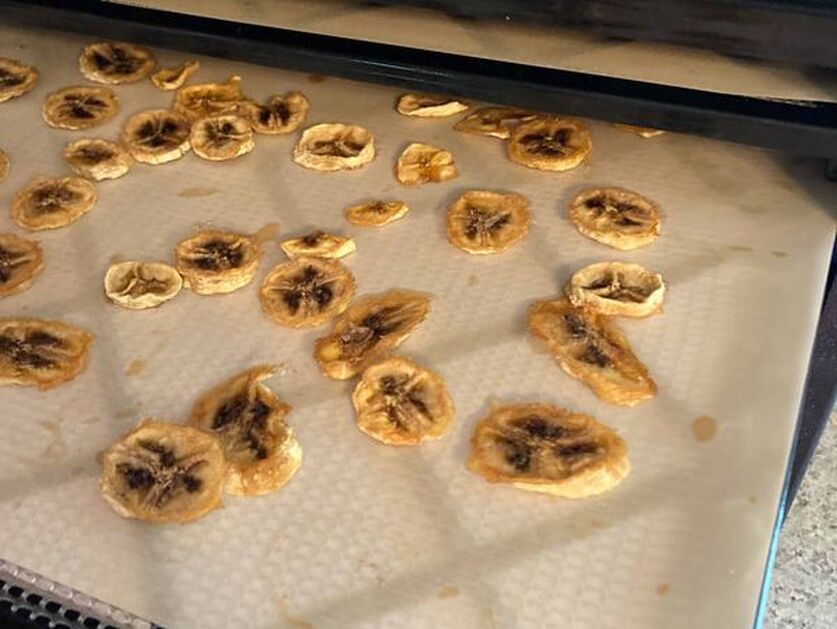|
Anyone remember growing up watching 90’s infomercials featuring countertop rotisseries, mini style blenders, and magical stain removers? I sure do, in fact I still get sucked into watching a few minutes of air fryer cooking or miracle wrinkle serum from time to time… Those audience chants are still burnt into my memory, “Set it and forget it!” :) At 9 years old, my grandmother gave into my 2 year plea for a food dehydrator. I was so excited to make fruit roll-ups, and jerky, and apple and banana chips, and dried soup packets for roughing it in the wilderness (it was a one hit wonder). Turns out it did all that and more. I have since graduated from my original food dehydrator, but it proved to be a great gift, a strange request from 9 year old, but a great gift nonetheless. Today, I’ll walk you through making fruit leathers, banana chips, and apple chips. It’s a great way to turn fresh food that’s getting a bit too ripe into shelf stable snacks. PLUS you’ll be able to avoid the preservatives, added sugars, and the steep price of store bought dried foods. Let’s get started! Gather your ingredients and supplies. I’m using some over-ripe bananas, a bruised apple and multiple jars of homemade applesauce. The applesauce is from last year's summer apples which ripen in July, tend to be tart, and soften quickly when cooked. The sauce quickly became too sour for my kids when the sweet apples came on in the fall. Lucky for me, I have found that it makes terrific fruit leathers. I can use the applesauce plain, add in some maple syrup, blend it up with some berries and a pectin package to keep it flexible, or like I will be doing today, you can add in a package of flavored gelatin. You’ll also need some citrus juice (lemon or lime works great), some cooking spray or oil (I like coconut oil), a sharp knife, cutting board, bowls, rubber scraper, and a food dehydrator. If you don’t have a dehydrator, consider borrowing one, to see if it is worth the investment. To prepare the fruit, just slice, dip in citrus juice (this helps prevent browning), and place on a greased food dehydrator tray. Try to slice everything as evenly as possible, to standardize drying time. To prepare fruit leather, pour applesauce into a bowl. (If you’re using plain applesauce just dump directly onto the dehydrator tray and smooth it out.) Add in flavoring (the sky's the limit) and mix thoroughly. Pour out on greased dehydrator tray (you’ll definitely need a liner on the tray, so the sauce doesn’t pour through the slats in the tray- if you don't have this accessory, cut some parchment sheets to fit) and spread in an even layer. The thicker the layer the longer it will need to dehydrate. I aim for about half a centimeter thick. Load your trays in the dehydrator. I like to fill mine when I run it, I figure it maximizes my return on energy consumption. I have found that using a fruit leather sheet on every tray makes clean-up a breeze, no matter what I am dehydrating. I usually set things up so that it will run overnight for about 12 hours, but times vary depending on how much you're dehydrating, what the moisture content of the food is, what climate you live in, and what model of dehydrator you are using. Completed banana chips will be dry and no longer mushy, but will still be flexible. Apple chips will be crisp and will snap when you try to flex them. Fruit leathers will be dry on top and bottom, with no remaining tackiness, they may need to be flipped the last few hours of dehydration to thoroughly dry the underside. They will be flexible and chewy. Cut fruit leathers with a pair of kitchen scissors. Store your final product in airtight containers, I like pyrex or mason jars. It’s important to let everything cool at room temperature before placing it in storage containers, otherwise you could create condensation and reverse your dehydration. For longer term storage, I vacuum seal dehydrated fruits and vegetables in Food Saver bags or mason jars. This makes them pantry stable for 6-12+ months. Plus, it uses up a lot less pantry space. Some of my family's favorite dehydrated foods are cherry tomatoes (we call them tomato raisins), jerky, dried herbs, and pineapple. We frequently open up a jar of dehydrated banana chips to treat our children’s growing pains naturally. It's a great way to show kids that food can literally be our medicine. This summer I plan on experimenting with making zucchini chips in the dehydrator. I recommend dehydrated food for children with a full set of chompers, it can be very chewy and could present a choking hazard for little ones with only a few teeth. Here’s to throwing out less food, creating healthy snacks, and trying something new! Sara Lynn, RN, BSN “If you don’t invest in your health, no one else will.”
0 Comments
Your comment will be posted after it is approved.
Leave a Reply. |
Blog Info
Archives
June 2024
Categories
All
|
|
Visit our Locations
IFM | West Des Moines 475 S. 50th St., Suite 600 West Des Moines, IA, 50265 *Temporarily Closed* IFM | Ankeny 207 NE Delaware Ave. Suite 20 Ankeny, IA 50021 |
Office HoursMonday 9:00 a.m. - 5:00 p.m. Tuesday 9:00 a.m. - 5:00 p.m. Wednesday 9:00 a.m. - 5:00 p.m. Thursday 9:00 a.m. - 5:00 p.m. Friday by appointment. Sat & Sun Closed |
© 2024 Integrative Family Medicine of Iowa, PLLC.
All rights reserved.
All rights reserved.













 RSS Feed
RSS Feed

